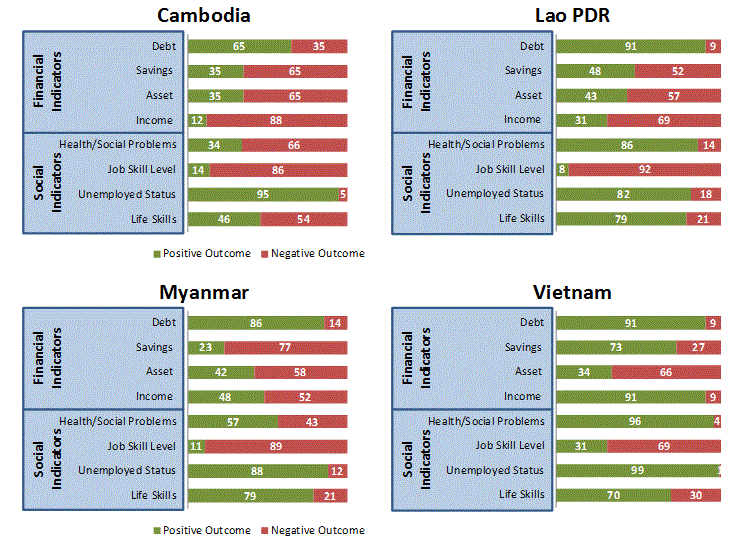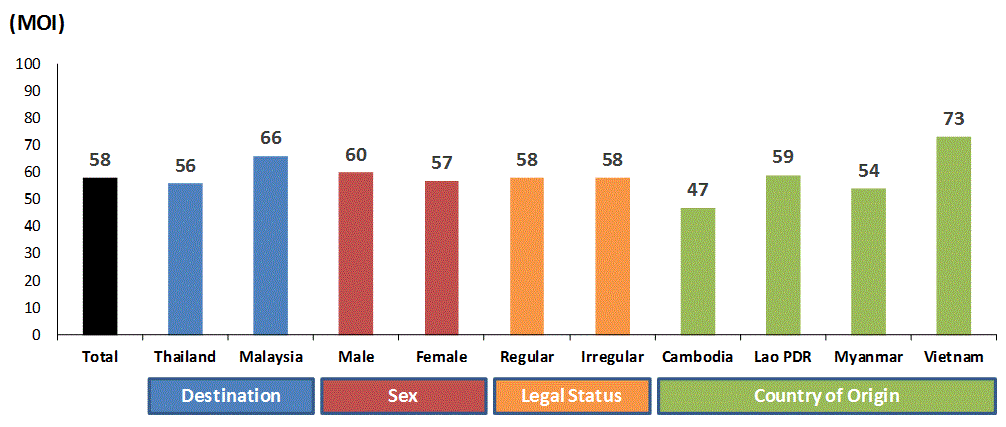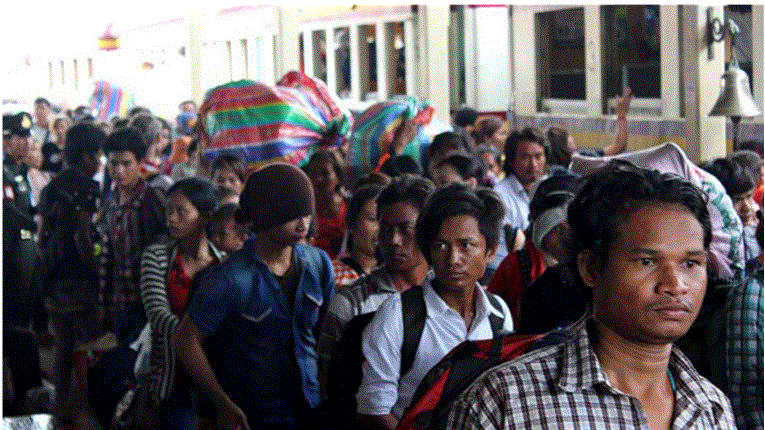Photo : Undocumented Cambodian migrants arrive by train at Anranya Prathet, Thailand prior to onward transportation to the border. © International Organization of Migration 2014, Joe Lowry
Proponents of labor migration argue that migration brings more benefits than disadvantages for those migrating overseas to work. Despite risks of labor abuse, exploitation, and in some cases human trafficking, the majority of labor migrants stand to benefit. But how can positive outcomes be determined and measured? In a recent study with return migrants in Cambodia, Lao PDR, Myanmar, and Vietnam, Rapid Asia, ILO and IOM collaborated and developed a migration outcome index (MOI). The full report can be found here.
Migration outcomes have traditionally been measured by looking at financial outcomes such as remittances. But considering all the possible outcomes that potentially affect the lives of migrants, considering remittances alone is a rather crude measure and does not take into account the importance of social dimensions that also play an important role. To create a better measure, an index was developed that took several outcome dimensions into account, looking at both financial as well as social factors.
The 8 factors shown in Figure 1 below (four financial and four social) were selected after developing and testing combinations of several different factors. The factors selected were found to vary quite independently of one other, and varying results across countries indicate they are largely mutually exclusive and help to capture different aspects of the overall migration experience. The 8 factors were organized into dichotomous variables, showing a positive result when migrants experienced a positive outcome upon return, and negative in cases of no change or a negative outcome. Figure 1 below shows the individual MOI indicator outcomes across the four countries, where positive outcomes are represented by the green bars and negative outcomes by red bars. The distributions of the MOI across individual migrants followed a normal distribution, and confirms the MOI helps to depict a wide range of migrant outcomes.
Figure 1: Item Analysis by Country

The MOI itself was indexed to a range from 0 to 100. Each indicator was given an equal weight, resulting in a 50/50 balance between financial and social outcomes. The benefit of the MOI is that it provides a shortcut to assessing migration outcomes by generating a single number score. This facilitates easier comparisons between different migrant groups, and easier identification of factors that contribute to positive or negative migration outcomes.
The overall MOI was 58 and serves as a reference benchmark against which migrant outcomes can be regarded as relatively better or worse. A three-point difference in the index between two variables can be considered as being significantly different. Figure 2 below shows the resulting MOI across destination countries, sex, legal status, and country of origin. In general, migrants who migrated to Malaysia were on average better off with a MOI of 66. There is some indication that male migrants were somewhat better off, but the difference is within the margin of error. Across countries of origin, on the other hand, some differences can be seen: migrants from Vietnam and Lao PDR were relatively better off compared to those from Cambodia and Myanmar. The fact that regular and irregular migrants ended up with the same MOI is interesting. It was found that while regular migrants can earn a higher income, they incur higher costs during the migration process. The opposite is true for irregular migrants, and highlights the tradeoff between economic savings and willingness to take on risk.
Figure 2: Regional MOI Benchmarks

The MOIs presented here represent benchmarks against which future initiatives can be measured. It also serves as good evidence for governments in Cambodia, Lao PDR, and Myanmar that organized migration can lead to better outcomes for their citizens, provided that migration costs are kept within reason. Further, women who migrate remain at a disadvantage relative to men and should be prioritized for support, especially in Lao PDR and Myanmar, where disparities were significantly larger. The 8 individual MOI indicators represent potential focal areas for future programming. Improving some of the indicators would result in an overall improvement in the MOI as well.
If you found this article useful, please remember to ‘Like’, share on social media and/or hit the ‘Follow’ button to never miss an article. You can find the full report here.
About the Author: Daniel Lindgren is the Founder of Rapid Asia Co., Ltd., a management consultancy firm based in Bangkok that specializes in evaluations for programs, projects, social marketing campaigns and other social development initiatives. Learn more about our work on: www.rapid-asia.com.

